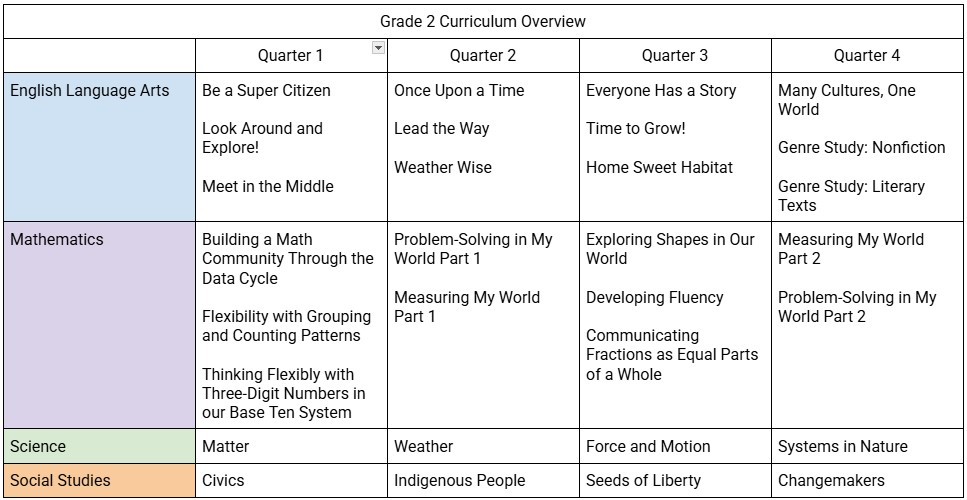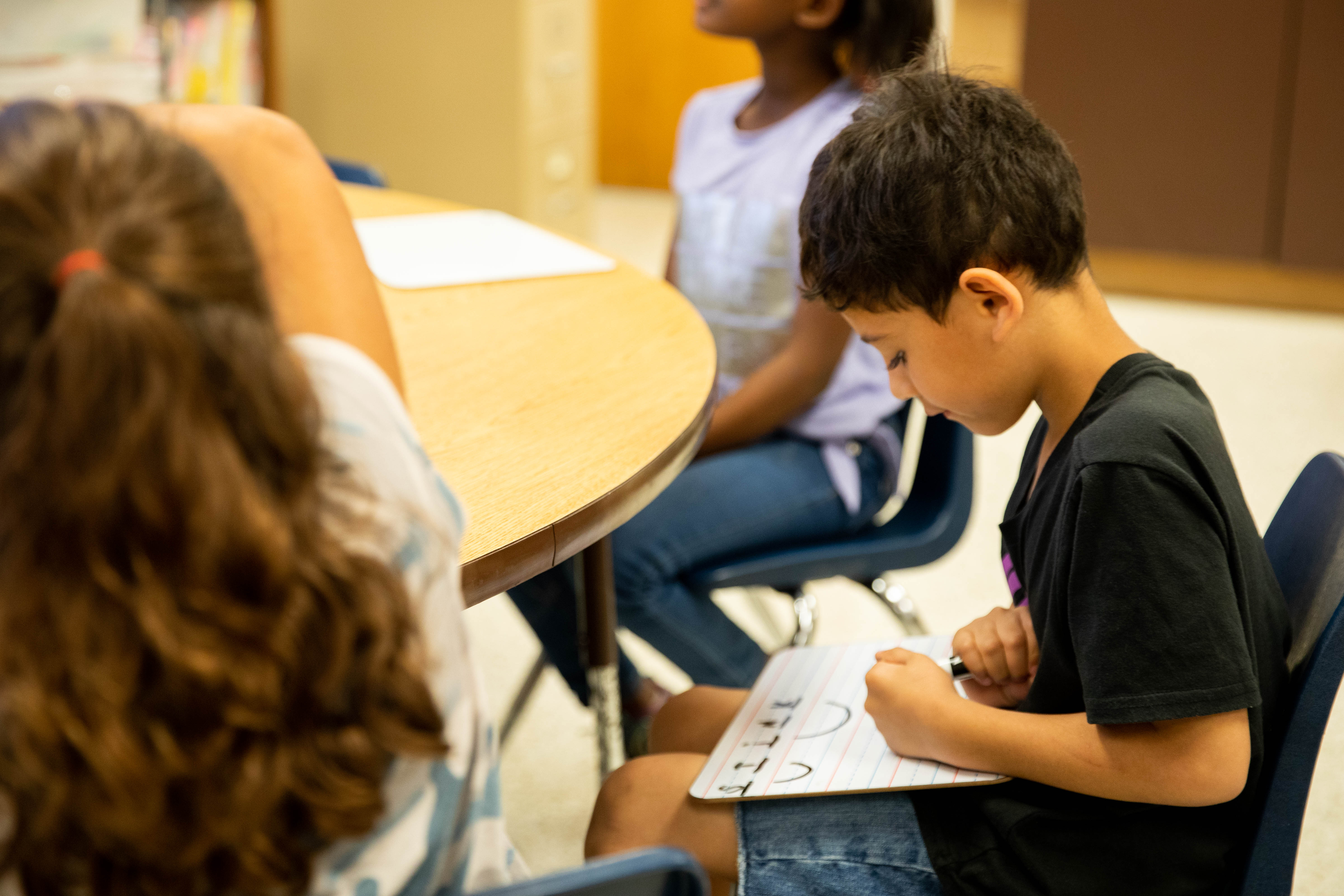
Language Arts
The second grade English language arts program focuses on the areas of foundations of reading, vocabulary, reading literary texts, reading informational texts, writing, language usage, communication, and multimodal literacies. Students will be introduced to a wide variety of literary and informational literature which will serve as a basis for instruction and practice in phonics, vocabulary, comprehension, fluency, and writing.
Foundations of Reading
- Orally identifies and produces various phonemes to develop phonemic awareness.
- Applies phonetic principles to read and spell words.
Vocabulary
- Builds vocabulary and word analysis skills.
Reading Literary texts
- Uses textual evidence to demonstrate comprehension of a variety of grade-level literary texts.
Reading Informational texts
- Uses textual evidence to demonstrate comprehension of a variety of grade-level informational texts.
Writing and Language Usage
- Prints legibly in manuscript and cursive and accurately spells grade-level words.
- Writes in a variety of forms.
- Uses conventions of Standard English when speaking and writing.
Communication and Multimodal Literacies
- Develops effective oral communication and collaboration skills.
- Conducts research to answer questions or solve problems.
Click here for a detailed storyboard for Grade 2 English Language Arts
Click here for more information about the Virginia Standards of Learning for Grade 2 Language Arts

Mathematics
The second-grade mathematics program continues to emphasize the patterns that exist in the Base-10 number system. Students develop strategies that help with basic addition facts and corresponding subtraction facts. A larger emphasis is placed on learning about rational numbers and part-to-whole relationships. Measurement becomes quantifiable through estimation and the use of standard units to identify length, mass/weight, and volume. Spatial relationships are explored by comparing and contrasting plane and solid geometric figures. The world is explored through the data cycle by posing questions and collecting, representing, analyzing and interpreting data. Algebraic exploration will focus on equivalence through solving for unknown values. Students will continue to recognize, identify, and extend repeating and increasing patterns.
Numeration and Computation
- Utilize flexible counting strategies to determine and describe quantities up to 200.
- Demonstrate an understanding of the ten-to-one relationships of the base 10 number systems to represent, compare and order whole numbers up to 999.
- Use mathematical reasoning and justification to solve contextual problems that involve partitioning models into equal-sized parts.
- Solve problems that involve counting and representing money amounts up to $2.00.
- Recall with automaticity addition and subtraction facts within 20 and estimate, represent, solve and justify solutions to single-step and multistep problems, including those in context, using addition and subtraction with whole numbers where addends or minuends do not exceed 100.
Geometry and Measurement
- Reason mathematically using standard units with appropriate tools to estimate, measure and compare objects by length, weight, and liquid volume to the nearest whole unit.
- Demonstrate an understanding of the concepts of time to the nearest five minutes, using analog and digital clocks.
- Identify, describe, and create plane figures that have at least one line of symmetry and explain its relationship with congruency.
- Describe, name, compare and contract plan and solid figures.
Probability and Statistics
- Apply the data cycle with a focus on pictographs and bar graphs.
Patterns, Functions, and Algebra
- Describe, extend, create, and transfer repeating and increasing patterns using various representations.
Click here for a detailed storyboard for Grade 2 Mathematics
Click here for more information about the Virginia Standards of Learning in Grade 2 Mathematics
Science
In second grade, the science program focuses on investigating and understanding patterns and change in the natural world. Students will continue to develop a broad range of scientific and engineering practices as they build upon their previous understandings of force, water, weather, plants, and animals and begin to explore these concepts through the lens of change.
Force, Motion, and Energy
- Explain how forces, including magnetism and gravity, can cause an object to move
Matter
- Explain that matter has mass and takes up space
- Investigate and identify the distinguishing characteristics of solids, liquids, and gases
- Describe the transformation of matter from one phase to another
Living Systems and Processes
- Describe life cycles of plants and animals
- Describe how living things interact within a system
- Describe how habitats provide for animals’ needs and can change over time
Earth and Space Systems
- Explain basic weather phenomena and common storms
- Describe how weather data can help predict weather patterns and storms
- Describe the effect weather has on living things and on the environment
- Identify types of changes which can affect the land, to include erosion, weathering, storms, and seasonal changes
Earth Resources
- Identify and classify the sources and uses of plant products
- Describe the various ways plants provide for the needs of animals and can reduce soil erosion
Click here for a detailed storyboard for Grade 2 Science
Click here for more information about the Virginia Standards of Learning for Grade 2 Science
Social Studies
In second grade, students will develop understandings around four major units: Civics, Geography, History (American Indians) and Economics, through inquiry. The ideas and skills developed within these units, along with the study of influential Americans and American holidays, serve to focus students on the active ways that social sciences play a role in their everyday lives and that learning from the past helps us in the present.
Civics
- Practice and apply the traits and responsibilities of a citizen
- Understand the common principles that unite the American people
- Describe symbols and traditional practices that foster patriotism
Geography
- Identify the location of the continents, oceans, and major geographic features on maps and globes
- Identify the location of the equator, prime meridian and four hemispheres
History (American Indians)
- Describe how the American Indians of the Eastern Woodlands (Powhatan), Plains (Lakota), and Southwest (Pueblo) used their environment to meet their basic needs
- Explain the contributions of American Indians and how American Indian cultures have changed
Economics
- Describe the three major types of resources (natural, capital and human)
- Distinguish between the use of barter and money
- Explore the concept of scarcity
Famous Americans and Holidays
- Describe the contributions of selected individuals
- Describe why people of the United States celebrate major holidays
- Individuals who were influential in the American Revolution
Click here for a detailed storyboard for Grade 2 Social Studies
Click here for more information about the Virginia Standards of Learning for Grade 2 Social Studies
